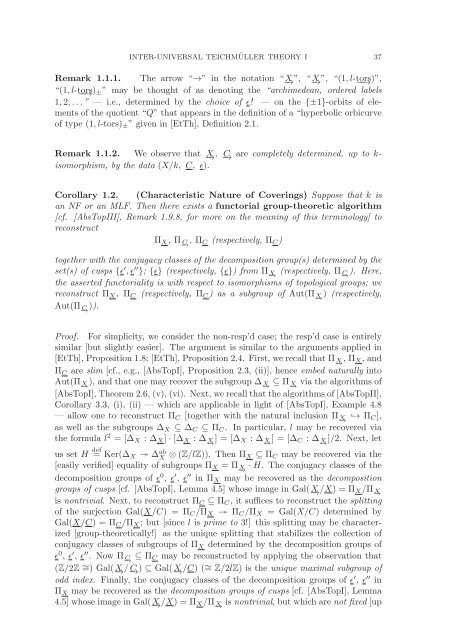Inter-universal Teichmuller Theory I: Construction of Hodge Theaters
Inter-universal Teichmuller Theory I: Construction of Hodge Theaters
Inter-universal Teichmuller Theory I: Construction of Hodge Theaters
You also want an ePaper? Increase the reach of your titles
YUMPU automatically turns print PDFs into web optimized ePapers that Google loves.
INTER-UNIVERSAL TEICHMÜLLER THEORY I 37<br />
Remark 1.1.1. The arrow “→” in the notation “X −→ ”, “X −→ ”, “(1,l-tors −−→ )”,<br />
“(1,l-tors −−→ ) ±” may be thought <strong>of</strong> as denoting the “archimedean, ordered labels<br />
1, 2,...” — i.e., determined by the choice <strong>of</strong> ɛ! —onthe{±1}-orbits <strong>of</strong> elements<br />
<strong>of</strong> the quotient “Q” that appears in the definition <strong>of</strong> a “hyperbolic orbicurve<br />
<strong>of</strong> type (1,l-tors) ± ” given in [EtTh], Definition 2.1.<br />
Remark 1.1.2. We observe that X −→ , C −→ are completely determined, up to k-<br />
isomorphism, by the data (X/k, C, ɛ).<br />
Corollary 1.2. (Characteristic Nature <strong>of</strong> Coverings) Suppose that k is<br />
an NF or an MLF. Then there exists a functorial group-theoretic algorithm<br />
[cf. [AbsTopIII], Remark 1.9.8, for more on the meaning <strong>of</strong> this terminology] to<br />
reconstruct<br />
Π X , Π C−→ , Π C (respectively, Π C )<br />
together with the conjugacy classes <strong>of</strong> the decomposition group(s) determined by the<br />
set(s) <strong>of</strong> cusps {ɛ ′ ,ɛ ′′ }; {ɛ} (respectively, {ɛ}) fromΠ X−→ (respectively, Π C−→ ). Here,<br />
the asserted functoriality is with respect to isomorphisms <strong>of</strong> topological groups; we<br />
reconstruct Π X , Π C (respectively, Π C )asasubgroup<strong>of</strong>Aut(Π X−→ ) (respectively,<br />
Aut(Π C−→ )).<br />
Pro<strong>of</strong>. For simplicity, we consider the non-resp’d case; the resp’d case is entirely<br />
similar [but slightly easier]. The argument is similar to the arguments applied in<br />
[EtTh], Proposition 1.8; [EtTh], Proposition 2.4. First, we recall that Π X−→ ,Π X ,and<br />
Π C are slim [cf., e.g., [AbsTopI], Proposition 2.3, (ii)], hence embed naturally into<br />
Aut(Π X−→ ), and that one may recover the subgroup Δ X−→ ⊆ Π X−→ via the algorithms <strong>of</strong><br />
[AbsTopI], Theorem 2.6, (v), (vi). Next, we recall that the algorithms <strong>of</strong> [AbsTopII],<br />
Corollary 3.3, (i), (ii) — which are applicable in light <strong>of</strong> [AbsTopI], Example 4.8<br />
— allow one to reconstruct Π C [together with the natural inclusion Π X−→ ↩→ Π C ],<br />
as well as the subgroups Δ X ⊆ Δ C ⊆ Π C . In particular, l may be recovered via<br />
the formula l 2 =[Δ X :Δ X ] · [Δ X :Δ X−→ ]=[Δ X :Δ X−→ ]=[Δ C :Δ X−→ ]/2. Next, let<br />
us set H def<br />
=Ker(Δ X ↠ Δ ab<br />
X ⊗ (Z/lZ)). Then Π X ⊆ Π C may be recovered via the<br />
[easily verified] equality <strong>of</strong> subgroups Π X =Π X−→ · H. The conjugacy classes <strong>of</strong> the<br />
decomposition groups <strong>of</strong> ɛ 0 , ɛ ′ , ɛ ′′ in Π X mayberecoveredasthedecomposition<br />
groups <strong>of</strong> cusps [cf. [AbsTopI], Lemma 4.5] whose image in Gal(X −→ /X) =Π X /Π X−→<br />
is nontrivial. Next, to reconstruct Π C ⊆ Π C , it suffices to reconstruct the splitting<br />
<strong>of</strong> the surjection Gal(X/C) =Π C /Π X ↠ Π C /Π X = Gal(X/C) determined by<br />
Gal(X/C) =Π C /Π X ; but [since l is prime to 3!] this splitting may be characterized<br />
[group-theoretically!] as the unique splitting that stabilizes the collection <strong>of</strong><br />
conjugacy classes <strong>of</strong> subgroups <strong>of</strong> Π X determined by the decomposition groups <strong>of</strong><br />
ɛ 0 , ɛ ′ , ɛ ′′ . Now Π C−→ ⊆ Π C may be reconstructed by applying the observation that<br />
(Z/2Z ∼ =) Gal(X −→ /C −→ ) ⊆ Gal(X −→ /C) ( ∼ = Z/2lZ) istheunique maximal subgroup <strong>of</strong><br />
odd index. Finally, the conjugacy classes <strong>of</strong> the decomposition groups <strong>of</strong> ɛ ′ , ɛ ′′ in<br />
Π X mayberecoveredasthedecomposition groups <strong>of</strong> cusps [cf. [AbsTopI], Lemma<br />
4.5] whose image in Gal(X −→ /X) =Π X /Π X−→ is nontrivial, but which are not fixed [up
















